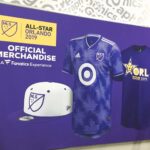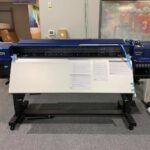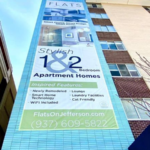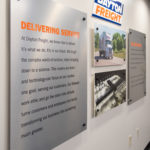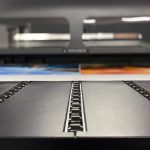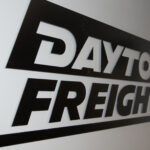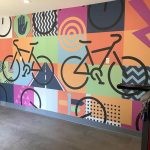From our clothes to curtains to comforters, we’re used to fabrics being an everyday part of our lives. However, when many people think of custom signage, they may picture materials like poster paper or vinyl instead. While these are popular materials, fabric is also an important material in the world of custom printing. Fabric is the perfect backdrop for creating eye-catching displays that remain strong and vivid over time. It’s also a convenient material to work with. There are many reasons to consider using fabric for your custom signage project.
WHAT IS FABRIC SIGNAGE?
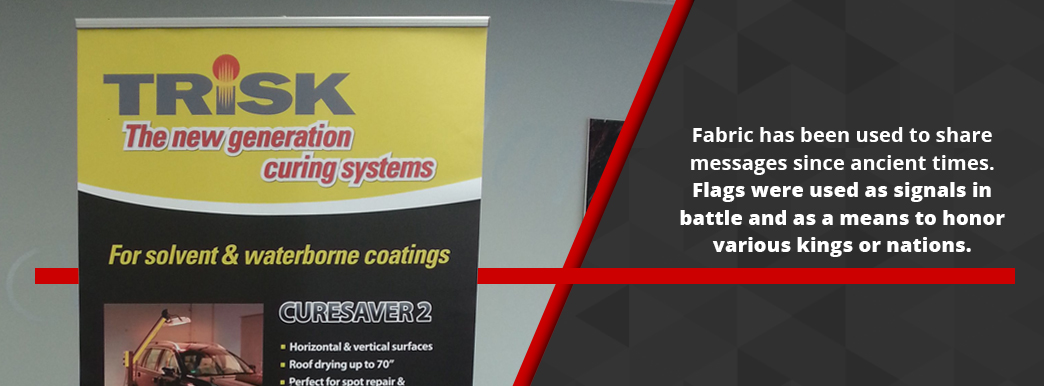
Fabric has been used to share messages since ancient times. Flags were used as signals in battle and as a means to honor various kings or nations. Banners were likewise associated with royalty. As new types of fabrics, weaves and dyes developed, fabric signage evolved and eventually expanded to the many types of fabric signs that are common today.
Flags are still produced using fabric today, and so are many banners. For banners and other types of signage, however, other materials such as vinyl have emerged and gained popularity. Though these newer plastic materials are great options to consider, the rich history and tradition of fabric signage give fabric banners and flags an unmistakable air of quality and craftsmanship.
One of the main differences between the fabric flags and banners of yesteryear and those of today is that fabric signs used to be largely limited to symbols and did not include text. Custom fabric banners and flags can include text along with vivid imagery, whether it be your company’s name or slogan or a promotional message about a product or sale. The options are endless when it comes to modern custom fabric flags and banners.
There are also other fabric products today that can be custom printed, such as table covers and pop-up displays. Fabric is an excellent option to consider for a wide range of projects because it looks highly professional and is made to last.
HOW DO YOU PRINT ON FABRIC?
In the past, fabric signs that weren’t just one color were typically created using the appliqué technique, where different-colored pieces of fabric were sewn onto a larger base piece of fabric to create a picture or pattern. While appliqué is still a valued art form, banners and flags today tend to be produced using more modern printing technology.
There are two methods commonly used for printing on fabric today — vinyl imprinting and dye sublimation.
1. VINYL IMPRINTING
One option is to transfer vinyl onto fabric using heat. This method is commonly seen on T-shirts. You can print an image onto the vinyl and then cut and transfer it, or you can use a solid-colored sheet of vinyl and simply cut out the shapes or letters you want and then transfer those onto the fabric. These vinyl imprinted fabrics cost less than dye-sublimated fabrics because the quality is lower, but they’re still a great option to consider.
2. DYE SUBLIMATION
Whereas with vinyl imprinted fabric, the graphic sits on top of the fabric, with dye sublimation, the graphic penetrates deep into the fabric, making it a permanent part of the fabric. The graphic is first printed backward onto a special type of heat-resistant transfer paper and is then placed onto the fabric so that the image is facing correctly. Heat is used to press the image into the fabric. This process results in high-quality fabric signage that is made to last. You can even wash or dry clean the fabric without harming the graphics.
WHAT TYPES OF FABRICS ARE USED FOR FABRIC SIGNAGE?
A wide variety of fabrics can be used for custom printing. The most popular options for banners, flags and more tend to be synthetic fabrics such as oxford fabric and display polyester. Polyester is a common ingredient in many types of fabric displays since it is a durable, high-performance option and is wrinkle-resistant. In some cases, a material may be 100% polyester, while others may include polyester in a blend with other materials, such as rayon.
Fabrics can also be treated to enhance their durability, especially if they’re intended for outdoor applications. In addition to treated synthetic fabrics, another option for outdoor displays is outdoor canvas. Canvas can also be made from polyester, or it can be made from cotton. It can also be a blend of the two. Many canvas materials today also include polyvinyl chloride (PVC) in their composition. Canvas is already a durable material, but outdoor canvas is treated to be especially weather-resistant.
If you’re interested in creating fabric displays, a SpeedPro representative can help you find the perfect fabric for your needs. A chief concern is whether the fabric display will be inside or outside. You can also discuss the price point you’re looking for and any other preferences that might influence your choice.
WHAT TYPES OF DISPLAYS ARE MADE FROM FABRIC?
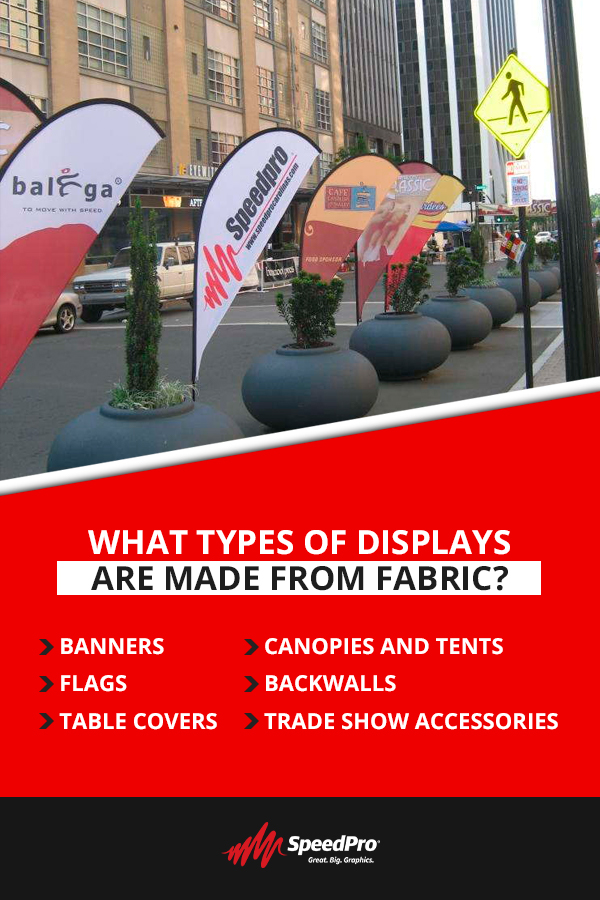
Because fabric is such a versatile material, there are many different types of displays that can be produced using fabric. Here are some of the most common ones:
1. BANNERS
Fabric custom banners are a popular option for sharing your message in style. You can choose a hanging banner any size up to 10-by-10 feet, or you can choose a standing banner. With a fabric frame banner stand, you either slip your pillowcase-style graphic over a frame, or you push the fabric banner material into the frame along the silicone-lined edges, where it is held in place. You can choose materials for indoors or outdoor fabric banners. You can also opt for illuminated fabric banner stands for impactful backlit displays.
2. FLAGS
Custom flags are another common type of fabric display. You can purchase established flag patterns, such as national or state flags, from a retailer since these flags are not custom. Custom flags must be specially ordered from a print studio. Companies can use custom flags, which come in a variety of shapes and sizes, to get the public’s attention with their banding or a temporary message about a sale. Since flags move with the wind, they are a dynamic display.
3. TABLE COVERS
You’re probably used to using tablecloths in your home in colors and patterns you enjoy. You can also use custom table coverings for your business to add an extra dose of professionalism to any display. For example, if you have a booth space at a trade show or street fair, you can drape a custom tablecloth over your table, and immediately let passersby know what company you’re representing. It also gives a polished look to your booth.
4. CANOPIES AND TENTS
Custom event tents are a great way to represent your business at an outdoor event such as festival, sporting events, craft shows and more while providing some shade for your employees and guests. Tents can also help your booth stand out at indoor events like trade shows. Tents can be made out of a variety of exterior-grade materials, including outdoor fabrics. The tents are comprised of frames and fabric panels to either provide just a roof or a roof and sides.
5. BACKWALLS
Fabric is an excellent option for trade show displays, especially when it comes to backwalls and backwall kits. Backwalls provide a branded backdrop for your booth. These backwalls start with metal frames. You either slip a pillowcase graphic over the frame or use a silicone-edge graphic (SEG) that locks into the frame along the edges. These SEG displays are 1 to 4 inches thick which helps them pop. Fabric backwalls help you make an impression, even when surrounded by many other booths.
6. TRADE SHOW ACCESSORIES
You can also incorporate fabric structures into your trade show booth or other exhibiting space through accessories like counters, kiosks and tablet stands. These structures add functionality to your booth, either by helping you introduce a multimedia element or by giving you a surface for setting items and interacting with visitors. By choosing customized fabric accessories rather than just buying or renting a plain counter or kiosk, you can promote greater brand awareness and maintain a professional image.
Note that many of these displays include hardware to help support the fabric. In some cases, fabric graphics are held in tension by a metal frame. These are fittingly called tension fabric displays. In other cases, the hardware may be as simple as a flag pole or grommets along the edges of a banner to help with hanging.
WHAT ARE THE BENEFITS OF FABRIC SIGNAGE?
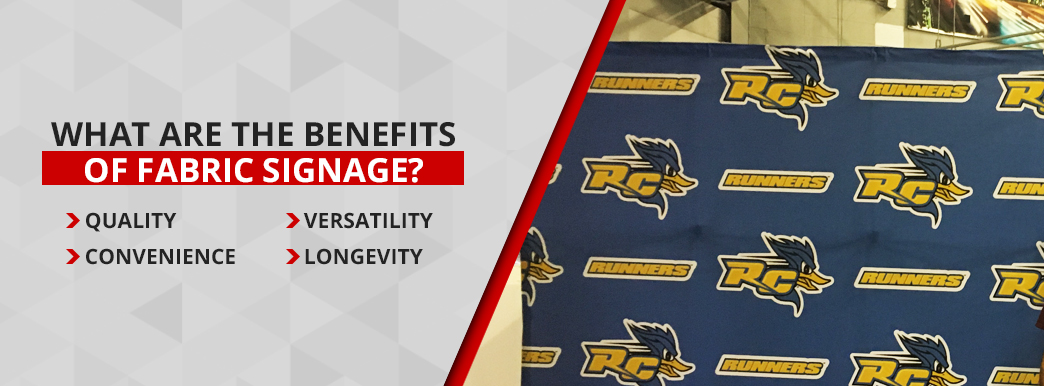
Fabric displays have become increasingly popular in recent years for advertisers for some notable benefits that fabric offers compared to alternative materials. When you choose fabric for your display, you enjoy the benefits of:
- Quality: Fabric is more permanent than many other types of materials, which makes it appear higher quality. Consider the difference between a plastic table covering and a fabric one in your home. In the same way that fabric can give a polished look to your home, it can give a high-end, finished look to any business exhibit.
- Convenience: Fabric is also a convenient option since it is so easy to display. Whether it’s a banner stand, flag or backwall, setup is typically quick and easy. Another aspect of fabric that makes it so convenient is how portable it is. Fabric can be folded up and carried to and from events with ease. With many fabrics, you don’t even need to worry about wrinkling.
- Versatility: Fabric, like many other materials SpeedPro uses, is extremely versatile. It can be used for a variety of display types and applications. Fabric displays can be customized in many ways, including the type of fabric, size, shape and more. Since fabric is translucent, it’s also perfect for backlit graphic displays.
- Longevity: Finally, fabric displays are made to last. Fabric is well-suited to long-term installations and event signage you plan to use repeatedly. Outdoor fabrics are especially durable and withstand the elements for years without the quality of your graphics being compromised. Dye-sublimated graphics are washable, which helps them stay fresh over time.
WHERE CAN YOU USE FABRIC DISPLAYS?
Fabric displays are incredibly versatile and can be used in a wide variety of places. Here are a few excellent places for fabric displays:
- Community events: Fabric displays are perfect for community events, whether it’s a festival or charity race. You can incorporate fabric signage in the form of flags, tents, banners and more to help you promote your message or brand.
- Street fairs: Some companies benefit from participating in street fairs where they can set up a booth and share information about their services or sell products. A custom table cover and canopy or tent can help you create a defined, branded space.
- Trade shows: Cloth banners for trade shows can help elevate the professionalism in your booth. You can also incorporate fabric backwalls, counters and more for a consistent, polished look that is sure to make a positive impression with attendees.
- Churches: Fabric banners for churches can enhance a sanctuary with meaningful artwork and text. Many churches today have logos that appear on their sign, website and other promotional materials. Incorporating this logo into a banner makes it truly unique to your church family.
- Outside business: Fabric flags or banners outside of your place of business are an excellent way to get the attention of passersby and increase your brand awareness. An advantage of advertising outside of your building is that it can encourage people to step inside.
- Inside retail stores: Fabric banners are a great way to share promotional messages in your store. Fabric backwalls are also a great option for point-of-purchase displays that can capture customers’ attention when they’re nearing checkout.
- Conferences: Fabric displays are also a great option to consider for conferences. A banner stand and a custom table cover can help you welcome attendees to check in. Banners can also be used for signage throughout the conference venue.
- Weddings: You can also use custom fabric displays for personal events, such as weddings. A personalized fabric backdrop is an elegant choice behind a head table, and it won’t glare in photos like vinyl can. Tents and table covers are also options to consider.
- Graduations: Graduations are monumental events for students and for schools. Especially for universities, graduations can attract enormous crowds, so branded fabric backdrops and banners can help you decorate for this exciting occasion and promote your institution.

